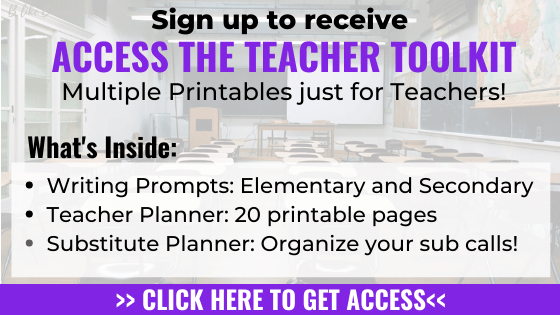Need some great great survival strategy student teaching tips? I got you covered! If you are interested in becoming a teacher, the student teaching practicum experience is the most important part of your educational journey. It is the hands on teaching internship, that upon success, will lead you to your teaching credential.
Depending on if you are on a quarter or semester-based system through your university, you can student teach anywhere from 12-16 weeks. In my opinion, the longer the better. You will literally want to gather as much information as you can, and soak it up like a sponge during this time.
How to Survive Student Teaching
For the most part you are putting your practice to the test. You will reflect, plan, prepare, observe, and then reflect some more, all the while delivering and designing lesson plans. Classroom Management is key, but you need to find your style – what you will or won’t put up with.
Reflection is the #1 thing you can do to get through student teaching. I kept an entire journal of my student teaching journey. I’m going to be really transparent and share my very first entry:
Student Teaching, Day 1, September 1
“Although I already am experiencing the expected, I’m still nervous about the upcoming weeks. I just want to be able to perform as a teacher in a professional manner and make strides as a beginning teacher. I hope not to make many mistakes and just want to view as much as I can to grow as a teacher. I have so many things going on, I don’t know where to turn. I’m just going to keep plunking along as normal. Meeting new people, keeping myself busy through these new relationships. I don’t know where or all this is going to go in the next few months. I’m just trying to make the most of my life being in my twenties on the down hill to thirty, I can’t wait until student teaching is over, but I remember I couldn’t wait for it to start.”
After reading it, a quite a few times afterward, I would’ve never knew the changes that were ahead of me. But I was scared, nervous, unorganized, and had a bit of anxiety that, at the time, I didn’t know how to deal with at all. I needed some student teaching tips just to survive!
Today, I know how to navigate the unknown. But while student teaching is very do or die, sometimes you won’t always get the best cooperating/supervising teacher. So hopefully these student teaching tips will help see your through to graduation and teacher certification.

Student Teaching Survival Tips
Ask Questions– You should have two supervisors. On being your classroom teacher supervisor and the other, a field experience supervisor that is connected to your university. Always ask them questions because it will look like you are engage when you may not feel it.
Continually ask where and what you can improve improve on within your teaching.
*Bonus: Ask your students for feedback on your teaching, they are usually honest and get straight to the point.
Keep all materials digital and hard copies- Get a folder and keep all lesson plans for your cooperating/supervising teacher, and lesson plans you make in a folder. I still have my student teaching binder with all my lesson plans in it. I go through it all the time for materials.
Stay mobile- Or what I like to call it, “work the room” is sometimes difficult for some people to do. But it is best to stay on your feet and alert for student questions and checks for understanding.
You can catch little moments to have a seat. The best time is during student’s independent work time. Usually right in the middle of it. This will make a world of difference for classroom management as well.
Learn how to differentiate in the moment– Many new teachers don’t understand this quite well but this is just making a little changes for students, either as a whole class, individually, or maybe just a student group like English Language Learners or Special Education students.
For example, if you just gave an assignment where students need to answering 10 questions and you find a student struggling and on #2 while the rest of the class is on #7, cross out half of the questions and have the student finish #1-5.
This way the student can feel successful with accomplishing the task and you as a teacher can see if they understand the material with what was completed.
Get a copy of your building and district handbook. Before you begin, you will know where you will be placed. Make sure you get a copy of the building, district, and all staff and student handbooks for review. You want to be on the same page as everyone else.
Look for teachable moments– Teachable moments can happen at anytime. Most commonly they might happen with bullying or fights. Use that opportunity to relationship build, reflect, and come together.
Give choices– This could be as simple as picking their own independent reading books, partners for group, topics for writing, or project ideas. This should never be something they earned because choice gives buy-in to a lesson and that prompts engagement.
Allow students to set and track their own goals– Daily, Weekly, monthly, quarterly…have students track their own learning goals. This helps with motivation and engagement in your lesson.
Students also need to physically see that they are or aren’t making progress regularly. If your cooperating teacher doesn’t have something in place, start something. You will most likely get kudos for it.
Celebrate diversity– You want to make sure every student has a voice. If you need a simple idea, check this blog post I wrote on how to celebrate diversity.
Be flexible– Students thrive in places where there is flexibility and that not everything is set in stone.
If a student needs more time, give them time. If changes need to be made, allow it. This will also work wonders during collaboration and professional learning communities (PLC).
Build Relationships– The key to classroom management. You have to build relationships with your students so that there is a mutual respect. All it takes is a couple minutes of “How are you doing?” before starting your lesson. Take the time to learn one personal thing about each one of your students and go from there. Need virtual tips for online learning? Check here: Build Relationships Virtually
Get students out of their seat– Make sure to have your students get up at least once a class period. It could for something as simple as turning in their worksheet or picking up a text from the back of the classroom.
Leave the lectures to higher education. Involve students to discuss and work together during your lessons as much as you can. You should be a facilitator in the classroom as students are learning from each other.
Bonus. At the end of your student teaching practicum, make sure to get your mentor teacher a thank you gift. It could just be a simple thank you note that shows much teacher appreciation. Here are some teacher gift ideas.
The Student Teaching Experience in 2020-2021
It is really difficult to say what to expect this school year. The best student teaching advice I can give during this time is just to be diligent about not only have online teaching practice but in-class teaching practice as well. That may mean going another semester/quarter but it will be worth it in the end.
Final Thoughts
Regardless of where you are in your teaching journey, these student teaching tips will assist you for success in your career. Let me know if you have any tips you would like to add or any questions about student teaching!



